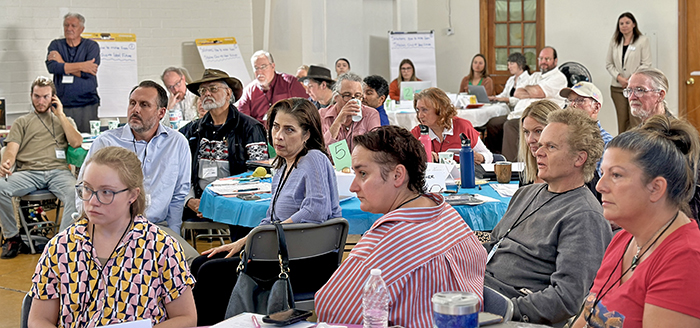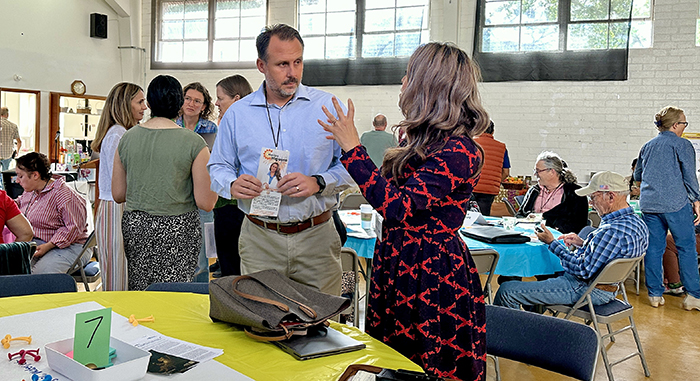
Charting a shared groundwater future in rural southern Arizona
In the small town of Patagonia, nestled in the rolling hills south of Tucson, water has long been both a defining feature and a pressing concern. Established as a railroad and mining hub in the late 1800s, Patagonia has transformed over time into a community prized for its unique character, rich ecology and abundant birding opportunities.
However, pressures including mining and drought are reshaping the local landscape, and the area faces new challenges in sustaining its most vital resource. Those challenges, and the opportunities to meet them, were at the heart of a recent rural groundwater resilience workshop organized by Impact Water – Arizona, a pillar of the Arizona Water Innovation Initiative, a statewide project led by ASU’s Julie Ann Wrigley Global Futures Laboratory in collaboration with the Ira A. Fulton Schools of Engineering.
The event was developed in collaboration with a local steering committee and brought together scientists, community groups, county leaders and local residents to discuss groundwater resilience and chart next steps for water management across the Patagonia–Sonoita–Elgin region. Like previous rural groundwater workshops in La Paz and Coconino counties, it was co-hosted by the Babbitt Center for Land and Water Policy, a center of the Lincoln Institute of Land Policy, the Arizona Institute for Resilience at the University of Arizona (U of A) and Southwest Decision Resources.
“My main purpose in applying for the workshop was to further collaboration and education throughout our region,” said Bob Proctor, president of Friends of Sonoita Creek, who applied to host the workshop through an open call from Impact Water - Arizona.

Proctor noted that the region’s biggest concern remains the impact of mining on water resources as the mining area is dewatered and that water is sent downstream. “The worry we have is that it’ll pick up contaminants on the way down,” he said. “Then it could affect the aquifer around Patagonia and further down the Santa Cruz River in Rio Rico, so monitoring is important.”
A region defined by water and change
Patagonia’s landscape tells a story of evolution from its early mining and ranching days to the advent of the Southern Pacific Railroad in 1897 to the rise of tourism in the 1960s and 70s. Today, the area, including nearby Sonoita and Elgin, forms the heart of Arizona’s first federally recognized American Viticulture Area, established in 1984, with 22 wineries spread across more than 300 square miles.

Uncertainty around water quality and supply are common here. Water sampling in nearby streams has shown traces of copper, zinc and phosphorus, while groundwater hardness and contamination risks remain persistent challenges. Groups like Friends of Sonoita Creek, The Nature Conservancy, Borderlands Restoration Network and the Sky Island Alliance have long collaborated to monitor and protect these waters.
The Patagonia workshop was a chance to bring these ongoing efforts together and to expand the conversation to include industry, government and residents. In that vein, the workshop opened with a series of scientific presentations from U of A experts setting the stage for community dialogue.

Neha Gupta from the Arizona Institute for Resilience provided an overview of the region’s groundwater systems, noting that evapotranspiration is the biggest demand in the area and highlighting the strong connections between surface and groundwater in the Cienega Creek and Sonoita Creek watershed.
Sharon Megdal, director of the Water Resources Research Center, then offered a primer on Arizona’s groundwater policy. She reviewed the state’s Groundwater Management Act and explained that while the Cienega Creek basin has not yet been designated for formal management, policy tools such as forming an Active Management Area (AMA) or Irrigation Non-Expansion Area remain possible.

Rounding out the scientific session, climate scientist Matt Meko from the CLIMAS program described how a warming climate and natural variability intersect to shape regional water futures, and in particular how increasing evaporation due to climate warming is stressing water resources.
Aligning land use and groundwater for a resilient future
Following the scientific presentations, a panel on development and growth brought diverse perspectives together under the theme of alignment between land use and community values.
Moderator Kristen Keener Busby guided a conversation featuring Patagonia Mayor Andrea Wood, Santa Cruz County Deputy Manager Chris Young, rancher Ian Tomlinson, Borderlands Restoration Network’s Chuck Klingenstein and winery co-owner Kati Spencer.

Mayor Wood emphasized that while Patagonia welcomes growth, sustainability and resilience are its guiding priorities. “The town needs to learn how to be sustainable as best as we can,” she said. Tomlinson, representing the ranching community, added that “dry years affect everything from cattle to creek levels,” calling for “more collaboration and fewer meetings.”
For the growing wine industry, Spencer described how water management directly influences production and pricing, while Chris Young highlighted Santa Cruz County’s efforts to craft a new comprehensive development plan and workforce strategy rooted in collaboration.
“These types of workshops where we get everybody’s representation from all around the community are very beneficial,” he said. “Any entity that comes here needs energy, water and workforce, but we also need to make sure it’s the kind of growth our community wants.”
Klingenstein closed the panel by praising the mix of participants, including South 32 representatives, saying, “We need to work together and not be in silos. Bottom-up approaches matter.”
From vision to action
By the final portion of the workshop, participants were ready to move from ideas to implementation. Building on earlier discussions in break-out groups focused on community vision and strategies, a third break-out session centered on action planning and identifying concrete next steps. Five key themes emerged from conversations that showed residents are ready to act.
The first revolved around state policy. Participants agreed that Arizona already has good policy frameworks in place and the conversation turned to identifying local champions who could advocate for groundwater protections, including a potential voter-initiated AMA.
The second theme focused on conjunctive management, or coordinating surface and groundwater management. Attendees proposed pilot programs that would bring together mining, agriculture, conservation and local government to test integrated management strategies.

The third focus area was recharge, where participants generated a wealth of ideas ranging from residential-scale rain catchment systems to landscape-level projects such as check dams and protecting mountain front recharge. A fourth theme emerged around county planning. Participants underscored the importance of reviewing the existing county comprehensive plan with an eye toward groundwater.
Finally, the group turned to community science and collaboration, which was perhaps the strongest thread running throughout the day. With multiple active monitoring programs already in place, participants discussed ways to build a regional coalition or network that could coordinate data collection and training.
Together, these discussions reflected a shared commitment to turn good ideas into tangible outcomes by taking action. As one participant put it, “Creativity and collaboration are what move us forward. Some ideas may be difficult or idealistic, but they’re worth pursuing.”
A shared path forward
As the workshop concluded, participants expressed optimism that the conversations begun here would continue through upcoming events like the upcoming Growing Water Smart workshop hosted by the Sonoran Institute and the Babbitt Center, and through initiatives such as the LABrary developed in collaboration with the Arizona Department of Environmental Quality, which aims to make community water monitoring more accessible.

“The county is very excited that this is happening,” Young said. “Events like this are beneficial not just for participants but for the region as a whole.”
Participants emphasized how rare and valuable it was to have a space where community members, scientists and industry representatives could listen carefully and learn from each other’s experiences. In a place where every drop counts, collaboration itself may be the region’s most important resource.
Retired hydrologist and Friends of the Santa Cruz River president Ben Lomeli agreed. “Anytime people get together and talk civilly about a subject like this and sift through the facts, it’s productive,” he said. “The more perspectives you have, the better conclusions you can come to.”
Story originally published at ASU News.
Related stories: